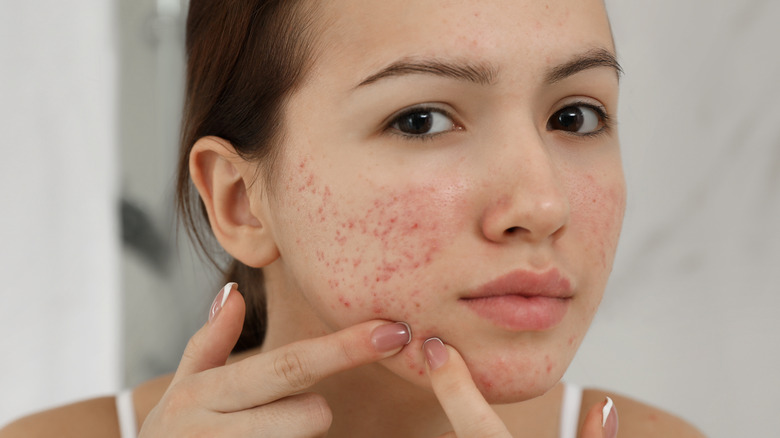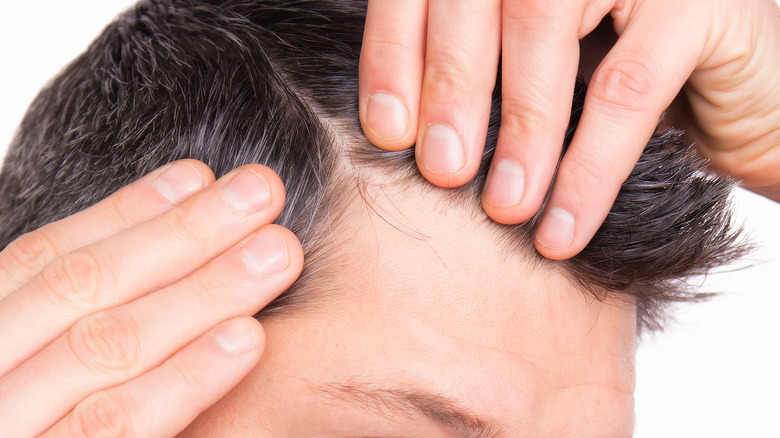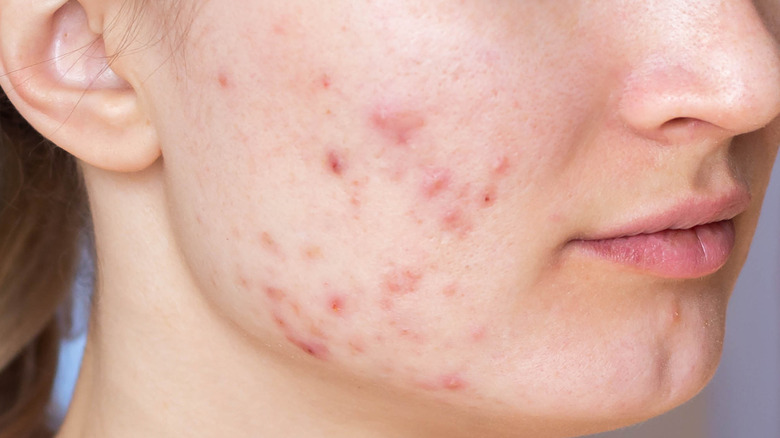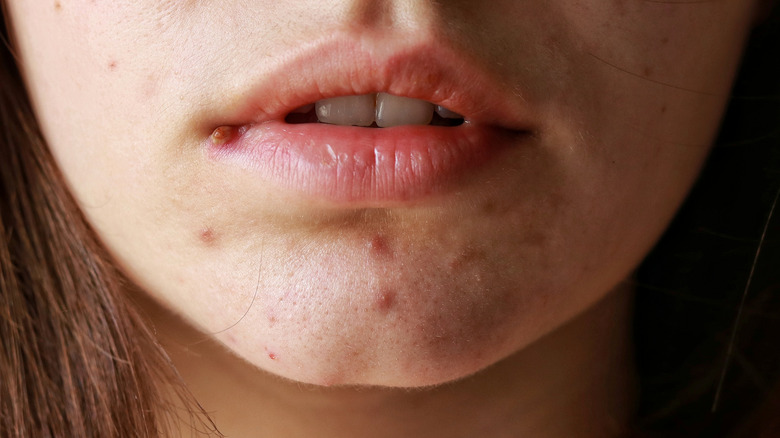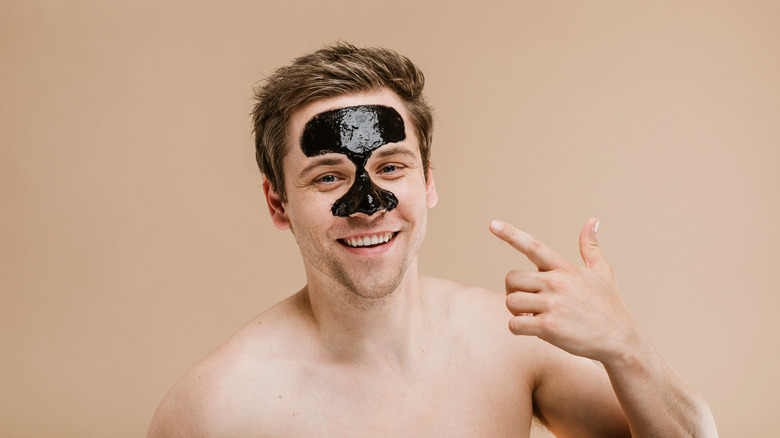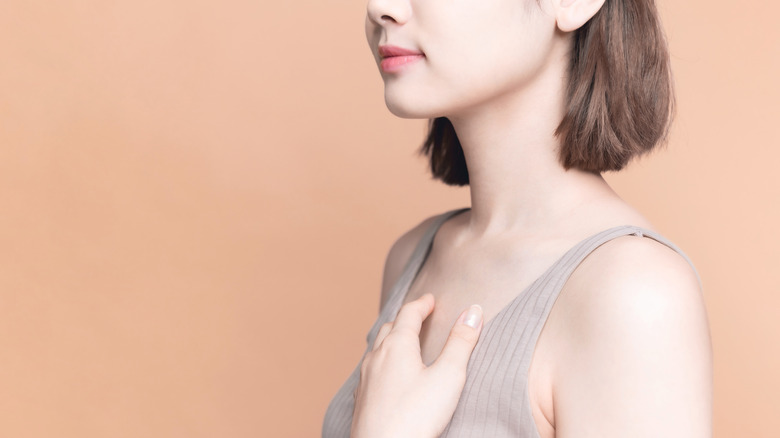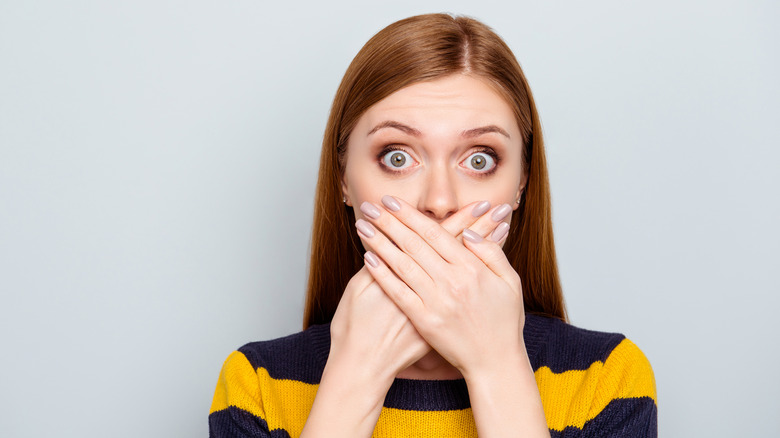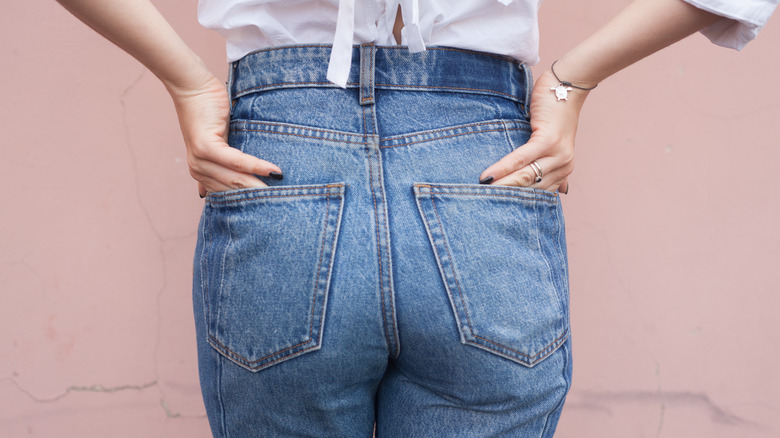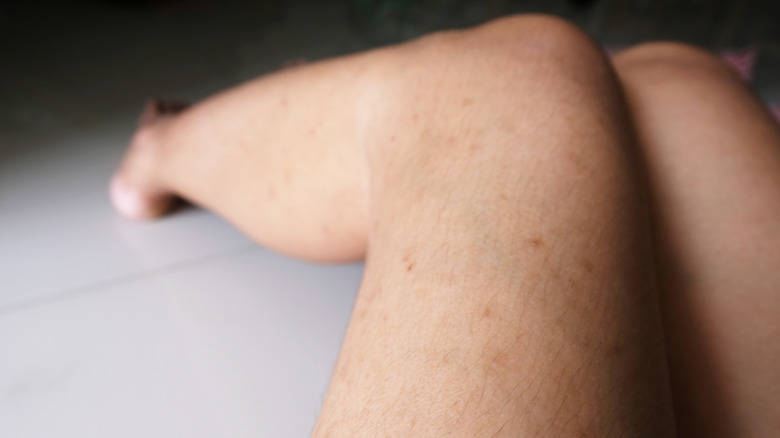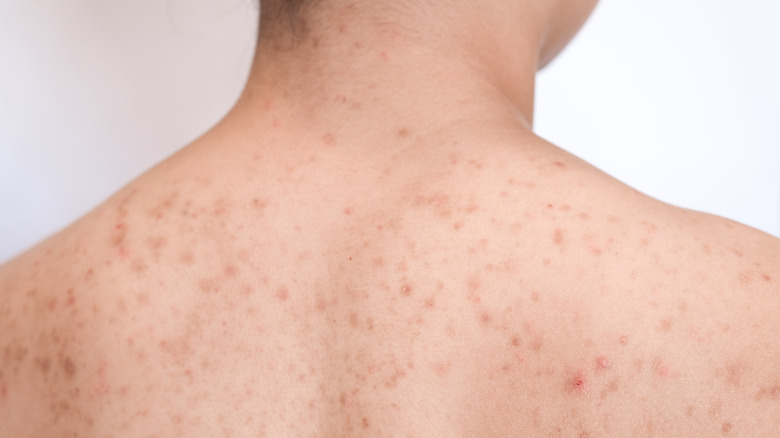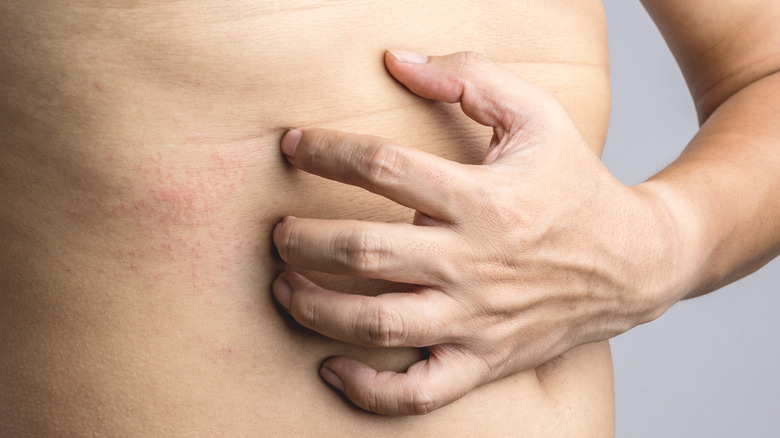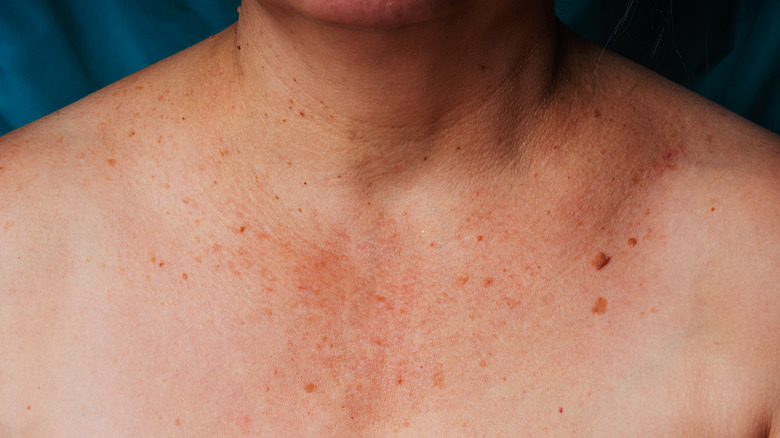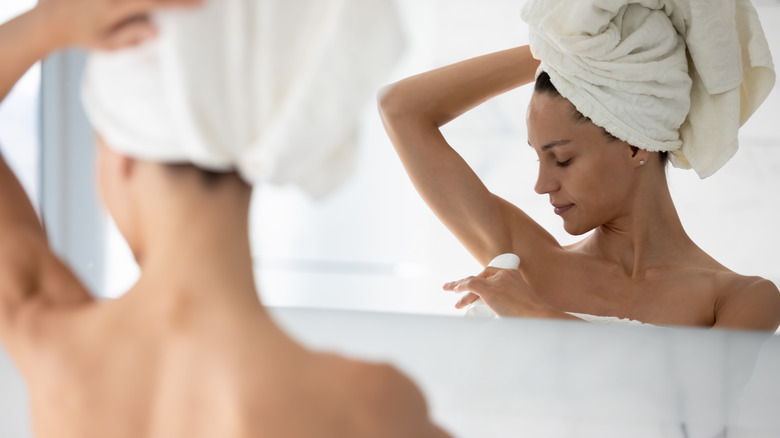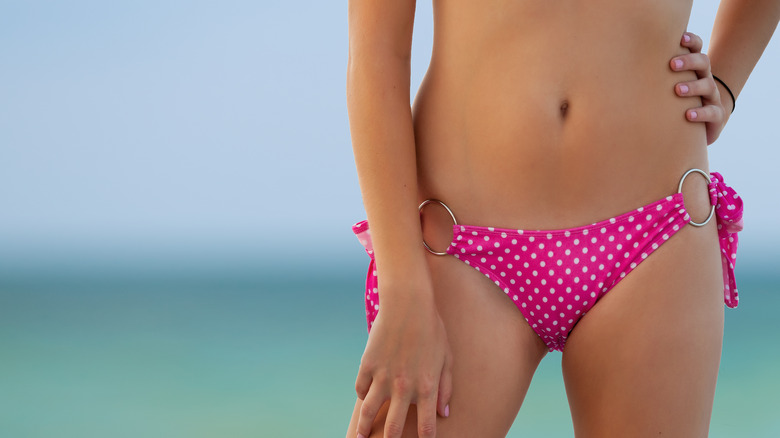What It Really Means If You Have A Pimple In One Of These Places
No matter your age, it's likely you've been plagued by pimples somewhere on your body at some point in your life. Whether you're prone to chronic acne or just the occasional (unfortunate) blemish, zits often appear with a message relating to your health. The location of your pimples can indicate their root cause, and depending on where those pesky bumps appear, there's a lot to discover about why they're appearing in the first place and what to do about them.
If you're patronized by pimple-prone skin, fear not! You're not alone. According to Women's Health, countless celebrities share that struggle. Stars like Mandy Moore, Chrissy Teigen, Kendall Jenner, and Rihanna have all opened up about their challenges with acne.
It's true: Women prove more susceptible to acne than men. The Journal of Clinical and Aesthetic Dermatology states that up to 22% of adult women face problematic breakouts, compared to less than 3% of adult men. Despite these stats, understanding the how and why of acne based on where pimples present on the body applies equally to the male and female population alike. Since none of us are guaranteed to escape the problems of pimples, we're exploring what it really means if you have pimples in any (or all!) of these varying places.
There are a couple culprits for hairline pimples
Most commonly, hairline acne results from an adverse reaction with products like shampoo, conditioner, or oil-based pomades. While the chemical compounds in these products may provide luxurious locks or bouncy curls and can eliminate frizz, those same solutions may also irritate the skin and, in turn, produce pimples by clogging your delicate pores, as noted by the American Academy of Dermatology. Similarly, common makeup products like concealers and foundations pose risks to hairline pores, especially when left on overnight.
Headbands, hats, and helmets also create hairline pimples thanks to friction with the skin and increased sweat production, as Buckhead Dermatology noted. When hidden under fashionable and functional headwear alike, pores fill with sweat and dirt particles, become clogged, and produce pus-filled pimples in response. Anything — hat, headband, softball helmet, or otherwise — touching your hairline for extended periods of time provides buildup with an opportunity to flourish and produce pesky pimples along the hairline.
Fortunately, there are prevention practices and treatment methods for managing pimples along the hairline. Doctors at Buckhead Dermatology suggest tipping your head back in the shower when rinsing out your shampoo and conditioner to let your products run directly toward the drain, versus flooding your pores. This simple technique limits the pores' exposure to irritable solutions and consequently helps prevent breakouts. While chronic hairline acne and overly persistent pimples may require the observation and input of your local dermatologist, most spontaneous hairline pimples can be treated with over-the-counter acne medication.
Pimples on your cheeks could be due to your phone, bed sheets, and more
Zits on the cheeks could essentially come from anywhere, whether it's stress, a genetic predisposition, a hormonal shift, clogged pores from dirty hands, or simply a fluke! More than likely, cheek pimples appear based on contact, either with an abrasive fabric, dirty pillowcases and sheets, or even your cell phone. Additional factors contributing to pimples on your cheeks include poor skincare, improper shaving techniques, hormonal changes, metabolic issues, nutritional imbalance, and, of course, touching your face too much with oily, dirty fingertips, according to bioClarity.
Before rushing out to purchase popular over-the-counter acne treatments with salicylic acid, benzoyl peroxide, or retinoids, first establish that the pimples invading your cheeks are in fact pimples. Sometimes a more serious dermatological condition called rosacea masks itself as common pimples, because rosacea portrays similar symptoms to standard acne. However, standard OTC acne treatments may make rosacea worse, so discovering the root cause of your cheek acne is pivotal.
One thing to keep in mind when tending to temperamental cheek pimples is that this area of your face is dryer than other spots and requires less topical treatment than other acne-prone areas. The Cleveland Clinic suggests avoiding applying acne medications to the cheeks on a daily basis. Instead, opt for an every-other-day regimen until the acne clears. During that time, do not forget moisturizer! Search for a light, water-based moisturizer that will avoid further clogging your pores and harboring a breeding ground for additional zits.
You can blame jawline and chin pimples on stress
Pesky pimples plaguing your chin and jawline? Lucky for you, there's a simple solution for lessening the effects of pimple pests. Acne in this particular spot indicates overly high stress levels or too much sugar consumption. Simply put, pimples on the chin and jawline are a tell-tale sign of a hormonal imbalance, which is why many notice breakouts here during ovulation and right before menstruating. Oftentimes, these hormonal breakouts are your body's natural response to stress, since stress stimulates androgen hormones, which then stimulate the oil glands and produce pimples along your chin and jawline, as Women's Health explained.
In addition to stress and diet, some popular medications generate problematic pimples along the chin, including oral contraceptives, antidepressants, corticosteroids, and even B vitamins (via Healthline). Because many of these medications are essentially irreplaceable, over-the-counter treatments containing salicylic acid or benzoyl peroxide may be the best solution for treating jawline pimples. Consult with your doctor or dermatologist before combining prescription and OTC medications, to ensure your safety against an adverse reaction.
If you are concerned about adding additional medications to your routine, a number of natural remedies for acne on the chin may better suit your needs. Natural remedies for jawline pimples include aloe vera, green tea extract, tea tree oil, zinc, and azelaic acid. Tea tree oil, specifically, can effectively alleviate problematic skin. Just be sure to dilute it.
Here's why you have pimples around your T-zone
The area including your forehead and down the bridge of your nose is best known in the beauty industry as the T-zone, and it's practically a breeding pool for blackheads and whiteheads, thanks to the increased oil production we experience in these spots. Those annoying, surface-level whiteheads and deeper rooted blackheads appear frequently along the T-zone because this area typically has more oil glands than other parts of the face, according to the Cleveland Clinic.
Despite many people enduring the irritation of troublesome T-zone pimples, especially during adolescence, there's one crucial pimple fact you may not know: Hot and muggy climates (think summers on the East Coast or any season in the southern-most states) can negatively impact acne production in this area in addition to external factors like pollution. But those living in dryer climates like those experienced during Northeast winters or those in Southwest states like Arizona aren't off the hook from weather-fueled T-zone acne. While warm and wet weather creates a breeding ground for oil products and increased breakouts, dry air reduces moisture in the skin and causes cells to build up dirt and dead skin in the pores, which in turn creates whiteheads, as noted by Women's Health.
Here's what may be causing your neck acne
While not overly common, pimples on the neck may be a sign of hormonal imbalance, overconsumption of refined sugars, or clogged pores from shampoo and conditioner as it lays on your neck in the shower, according to The Chalkboard. Similar to your T-zone, your neck hosts a greater amount of oil-producing glands than other areas of your body and, in turn, breeds unwelcome acne, as MindBodyGreen explained. Depending on the location of your unpleasant neck pimples, a number of these factors combined with clothing irritation may generate breakouts. From hair products to sweat to hormonal changes, pimples on the neck come from a wide range of root causes, some of which are easier to treat than others.
When treating unwanted neck acne, keep in mind the skin on this particular body part requires additional care thanks to its delicate texture in comparison to the body parts that can handle a bit of a beating, like the shoulders and forehead. Because of this added sensitivity, opt for over-the-counter treatments with lower chemical concentrations. MindBodyGreen suggests choosing an exfoliator that will clear out gunk without abrasively harming the sensitive skin covering the neck, and don't forget to moisturize to replenish and nourish the skin while simultaneously treating pesky pimples.
If you're getting pimples near your mouth, take another look at your toothpaste
If you're battling with pimples around your mouth, it could mean that you're using the wrong toothpaste. Like shampoo containing SLS (sodium lauryl sulfate), toothpaste with the compound can irritate the skin, as noted by Harper's Bazaar. Thankfully, switching to a fluoride-free toothpaste should clear pimples if SLS is the culprit. Similarly, cosmetics and shaving cream may be clogging your pores, too. If you play a sport, chin straps from helmets may irritate the skin surrounding your mouth, and even musical instruments like the trumpet or even violin can irritate your skin into a breakout frenzy, according to Healthline.
Notice throughout the day how many objects make contact with the area around your mouth — makeup brushes, cell phones, pillowcases, fingertips, the end of the pen you subconsciously chew, and more — and remember to clean each of these things often and thoroughly in an effort to prevent unwanted acne in this area. In addition to utilizing standard over-the-counter acne treatment products, consider getting a chemical peel done by a professional when managing frequent or chronic pimples around the mouth. Chemical peels offer a deep dive into your pores with powerful cleaning solvents to eliminate buildup and acne-inducing bacteria (via Stryx).
What to know about pimples on your butt
When it comes to the tush, there's likely one sole suspect for pimples: clogged hair follicles and blocked pores. During adolescence or adulthood, male or female, you're likely to experience some acne, mild or severe, on your butt at some point in your life. Blockage and build-up can accumulate especially after a sweaty workout, so try to change into clean, dry clothes ASAP after your gym session. While it is nice to know hormones and stress are not to blame for bumps on the bum, there is still some navigating to do when it comes to diagnosing what may or may not be pimples on your behind.
Additional pimple-like bumps that frequently appear on the bum include folliculitis, keratosis pilaris, and boils, according to VeryWell Health. Folliculitis simply means "inflamed hair follicle," and this inflammation comes from sweat and bacteria that can be found in places like hot tubs and pools. Keratosis pilaris (KP or strawberry skin) is wildly common and is often seen in families, although there is no known true cause for the small red bumps. Boils tend to be very large and very painful, and they tend to develop from a bacterial infection. Be sure to know the difference between derriere bumps before you attempt to treat them!
Leg pimples could be due to sweaty clothes
Similar to pimples plaguing the buttocks, pimples on the legs oftentimes sprout from folliculitis, eczema, and KP, according to VeryWell Health. Allergies and ingrown hairs also impact acne production on the thighs especially, as noted by The Chalkboard. Inflammation more often than not occurs if the clothes you're wearing are too tight and from excess sweat and wearing sweaty clothes for a long time. Additionally, pimples on the legs may stem from skin irritation when shaving.
To prevent experiencing pimples on your legs often, consider the ingredients in products you use on your legs, like soaps, laundry detergent, shaving cream, and lotions. When purchasing skincare products, opt for fragrance-free solutions to limit further irritation. If acne persists beyond a few days, contact your primary care physician or dermatologist as underlying risk factors contribute to excess pimples on the legs. Health conditions fueling pimples on the legs include being overweight, skin injuries, and conditions that prohibit the body's ability to fight infection like autoimmune diseases (via Medical News Today).
A lot of people have experienced a little bacne
Because pores on your back are larger than the ones on your face, they become clogged with dirt, bacteria, and sweat much more easily than other body parts do. Similar to your face, however, your back contains unique glands that produce an oily discharge. While this is healthy and normal, pimples pop up when the naturally produced oil combines with dead skin cells which clogs the pores and generates inflammation, according to Everyday Health. For many, "bacne" comes from lounging in lived-in workout gear that's drenched in sweat and harboring pore-invading bacteria. Pimples on your back likely mean you need to slough off your excess dead skin cells and oil accumulation with a shower immediately following your workout!
According to the American Academy of Dermatology, typically, you are safe to treat your back pimples at home, especially if you're seeing just a few bumps on your back, bacne is new to you, and none of the bumps are painful or deeply rooted. In addition to applying common OTC medications or topical treatments, try switching to oil-free cleansers and protect your skin from the sun, either with clothing or sunscreen. For specific treatment tailored to your unique back pimples, first determine whether your bacne is primarily whiteheads, blackheads, pustules, cysts, nodules, or papules.
Stomach acne isn't too common
Less common than many other pimple-prone places on your body, acne on the stomach likely means you're dealing with an ingrown hair or contact irritation from clothing, bedsheets, or towels. The limited appearance of stomach acne is mainly due to our bodies having less oil-producing glands on our tummies than most other places. However, tight, sweaty clothing may breed stomach acne, so if you are experiencing pimples in this uncommon area, switch up your wardrobe to loose-fitting, cotton clothing that will allow your pores to breathe. Acne generated primarily from friction with clothing is formally known as "acne mechanica," according to skincare company Tiege.
In addition to making a simple clothing swap to alleviate and prevent further breakouts of acne on the stomach, Healthline suggests a number of additional home remedies outside of standard OTC treatment methods. By applying a warm compress to the problematic pimples, your pores open up, drain the zit, and eliminate the bacteria that created the pimple in the first place. Hydrocortisone cream will treat dry, itchy pimples in the area, and witch hazel, a natural astringent, lightly wiped over the skin with a cotton ball will cleanse the area without added chemicals.
If you're seeing more chest pimples, consider what you're putting into your body
Breakouts on the chest bring to light a number of possible problems, including liver imbalances, allergic reactions, or an unhappy gut microbiome (via The Chalkboard). Stress, diet, hormones, and even certain medications impact the prevalence of pimples on the chest, as each of these influences oil production. If your chest is pimple-prone, your body may be alerting you of a food sensitivity or need for alternative food-based choices. Researchers at the Mayo Clinic suggest that skim milk, chocolate, and foods high in carbs may worsen acne, especially on the chest.
In addition to stress causing hormonal breakouts, medications like corticosteroids and testosterone also wreak havoc on hormone regulation (via U.S. Dermatology Partners). When taking prescription medication for various ailments, be wary of the possible reactions between your meds.
Additionally, topical products like soap and laundry detergent could potentially lead to chest pimples. You may also want to switch to a lotion that is less likely to clog pores than a thick, cream-based moisturizer.
Pay attention to armpit pimples
Pimples are a response to bacteria build-up in your pores, so it's no surprise that pits are prone to pimples thanks to deodorant and a natural haven for perspiration. However, zits in the pits also result from dermatitis, ingrown hairs, yeast infections, and razor burn, as noted by Byrdie. All of that, plus you may face an increased risk from plucking, waxing, shaving, sitting in a hot tub, or wearing tight clothes. Basically, blockage plus infection plus heat equals pimples, which makes sense as to why armpit acne is relatively common and effects both men and women alike.
While, like most other acute pimple problems, many armpit acne issues are treatable with over-the-counter topical medications, prolonged pit pimples may indicate a more serious issue: an autoimmune disorder known as hidradenitis suppurativa that leads to swollen pustules (among other problematic symptoms). As if that's not bad enough, hidradenitis suppurativa also causes acne spots to burst and leak a smelly discharge, which may lead to scarring (via SkinKraft).
Why you might see pimples around your pubic area
Best case scenario, you're dealing with an ingrown hair. Or maybe there's a hygiene discrepancy. Worst case, pimples around the pubic area may be alerting you to an STD, according to The Chalkboard, so you may want to see a doctor if you think that's a possibility.
Like the armpits, shaving and razor burn may generate pimples on the privates, too. Acne near the vagina may indicate it's time for a "vajacial," a steam-based treatment designed to rejuvenate and restore the nether region (via Cosmopolitan).
Outside of the most severe possibility, vaginal acne is typically no big deal and totally treatable. In combination with bacterial overgrowth, a hormone imbalance generates vulva acne, which typically contains more fluid than your standard pimple, as explained by The Healthy. If the pimples on your privates seem overly pus-filled, getting your hormone levels in check may be the solution. If ingrown hairs cause your pimple problem, take a break from shaving or waxing and grow out your pubic hair for a season. It's there for a reason, after all. In addition to standard acne treatments like wearing loose clothing (underwear, in this case) and practicing regular, thorough cleansing, avoiding sleeping in undies allows your vagina to breathe and air out, preventing sweat and unnecessarily clogged pores.
